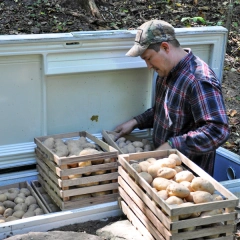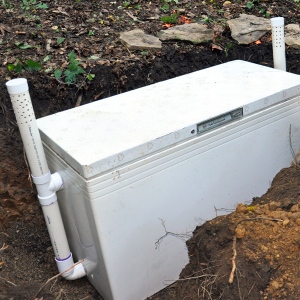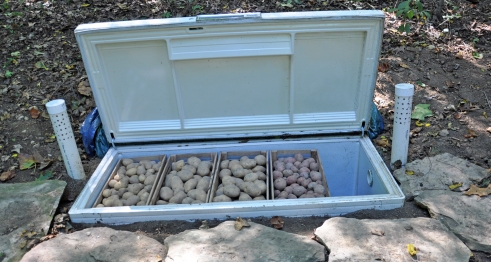We had a bumper crop of potatoes last year. After freezing them (as fries, casseroles, etc), canning some, and giving over 200 lbs away, we needed a reliable way to store the rest. The goal was to have enough potatoes stored to take us through to the next harvest…and possibly never to have to buy potatoes again. We didn’t have a basement or root cellar (or time/funds to build a full-blown root cellar), so we had to get creative. Clyde remembered his dad talking about burying old chest freezers for overwintering vegetables and we decided to give it a try. His sister’s freezer had recently died and so was recruited for the job.
Clyde removed all of the working parts and cut two holes in each side. (Note: if your appliance still contains freon, certified individuals can be hired for freon removal or these services may be available at area junk yards or recycling centers.) To the holes he attached PVC pipe for air circulation. When in the ground, it looked like someone had buried a semi. A tarp was partly buried as well in order to protect the freezer and allow easier access during icy conditions. We later added a sheet of insulation under the tarp as well. Clyde made crates for easier storage and better air circulation.With hopeful trepidation, we packed away our harvest. We were careful to store only the best potatoes and packed the smaller ones in the upper boxes so we’d use them first.
I’m pleased to report that our deep-freeze root cellar had great results! Mid-winter the potatoes looked just as we’d left them. In early spring only a little bit of sprouting had occurred. Later in the spring we sorted through some of the more deteriorated ones to use as seed potatoes for this year’s crop. Now, in late June, they are not as attractive out of the box, but most still scrub up well, are quite firm and have a good taste and texture. Although a true root cellar is still on the wish list, it’s nice to find an easy, inexpensive solution that works so well.

This post is part of Homestead Revival’s Homestead Barn Hop. Check out the rest of the great homesteady ideas and information by following the link!




What an absolutely great idea! I am in Florida and this would probably work here.
That is a great idea. I have a frige in the back that I grow my worms in, could easily add another one if we get enough to actually use it!
Even if in Florida it is possible for you to do this…However the catch would be you would have to bury yours a lot deeper in the ground…How deep?…i’m not sure, you might be able to do some research and find out..
I’ve got a couple of questions, how cold does it get where you’re at? Does the tarp cover the vent tubes or do you leave them exposed?
Hi Brice, We live in Central Ohio (the average low temp in January is 20 degrees.) The tarp does not cover the vents.
hey! where in central ohio? 🙂
I live in east/central ohio. Have you tried this with anything else? What size pvc pipe did you use? Thank you
We used 4 inch PVC pipe. No we haven’t tried it with anything else.
I was wondering if it would work in florida,.the heat ,..mmmm,..I will find a smaller one,.and see if this works,.love the idea!
In FL it’s really going to depend on how high the water table is where you are, many times it’s within feet of the surface. You can check with the county extension agent.
I wonder if this would work for cabbage and carrots to?
Good question. I know there are specific ways each crop needs to be stored and that some veggies shouldn’t be stored together, but basically it’s a mini-root cellar, so I don’t know why not…
Watch out with the cabbages – they contain a huge amount of moisture. My mom had all kinds of problems when she stored them in a large regular root cellar. The carrots should be fine
Pingback: Burying a Freezer | Joyful Home « Nub Shrub
I live in Central Ohio. So if you want to give some away this year, I will be happy to buy them from you.
Thanks! I’ll check back with you in the fall. We’re off to a dry start this summer, but so far our potatoes are looking good! 🙂
The first year we moved to Tennessee, we had the same problem and like you, someone told us about useing an old freezer, which we did. We stored it our unheated basement and used old newspapers between layers of potatoes, filling it about half of the way up. We had potatoes all winter and a good supply for spring seed potatoes. It worked great for us.
Brilliant idea. Wouldnt work here as it can get to -40 and -50 here in the winter.
Did you have to put screen on the tubes to keep out pests? (mice)
I don’t think mice could fit into the drilled holes, but bugs/spiders could, we just haven’t had any problems with them. I’m sure that screen could easily be added, and would probably be a good idea.
I have found that those cheap plastic pot scrubbers make a great insect screen for small pipes and still allow plenty of air circulation. I used one in my built in vac exhaust pipe.
“Working parts?” Does this include the freon?
The freon was already gone in the appliance we found. This is a good point, it’s my understanding that certified individuals can be hired for freon removal, or that these services may be available at area junk yards or recycling centers. Do not cut the lines and release the freon. We should have been clear on this point and will revise our directions accordingly. Good question.
Why is Freon removal professionally required ? Freon is HEAVIER than air and cannot get to the ozone to destroy it as we have been led to beleive. Another lie?
Honestly, I’m not sure about laws on this–maybe they vary state to state? It wasn’t something we dealt with personally, but some of the other readers had commented about it.
To Glen….https://www.scientificamerican.com/article/chlorofluorocarbons-cfcs/
Scientific America is a pretty trusted source. If dust particles can be carried to the stratosphere CFC’s would have no issues.
Juanita Morison here in Illinois I would love to plant enough potatoes to last I havent had fresh potatoes we growed since a kid could not believe the taste between one we growed and store bot dont know why but fresh tasted bette. We had thought
we dug them all up only to find out we didnt and the few we left in the ground we found this spring as he dug the plot for replanting this yer and they were delishes
That’s a good point. I leave beets, carrots and parsnips in the ground during winter months until I’m ready to use them.
If you bury it below the freeze line, you could probably make one even in -40/-50F as Earth’s temp is usually 50-70F. It might be worth a test run for just your starter potatoes.
How creative!! This is the only way these chest freezers will be used one day when the grid goes down! Haha! So you need air circulation badly? I never would have guessed that! It’s interesting that even insulated, being underground still keeps it cool? And the pipes don’t let moisture or warm air in?
I’m not sure what would happen without the air circulation. We don’t have trouble with moisture at all, but once the warm weather hits around April, the potatoes do start to sprout.
Clyde says it’s the moisture in the potatoes themselves that necessitate the circulation vents. Otherwise, they would be more likely to rot.
very neat idea! would it work in places it gets to -40C?
I’m not sure what the temperature limits would be, but the idea is that it stores the vegetables at ground temperature, which is supposed to standardly be about 50 F (10 C) at about 4 feet year-round.
are the ends capped? I can’t really see in the picture but looks they are, I was wondering about rain / snow getting in. I also live in florida so don’t think this would work for me. We live just a few miles from the ocean. Maybe in the more central part of the state would work.
Yes, they’re capped. We get plenty of rain and snow and havent’ had a problem with moisture at all.
Inviting you the Carnival of Home Preserving on my blog every Friday. Hope to see you there. Laura Williams’ Musings
The most recent edition – http://laurawilliamsmusings.blogspot.com/2012/06/carnival-of-home-preserving-13-come.html – open until Thursday 6/7.
Hi Mendy,
I’m not sure how I missed this post earlier, but all I can say is W.O.W.! This is awesome! I’ve heard about burying an old freezer, but I really appreciated your detailed instructions and I think the “vents” are a great idea. I’ve not heard that mentioned in such an application, but after reading the book Root Cellars, this makes total sense! I think I’m going to start looking for a new “old” freezer!
Most root vegetables can be stored this way, It is amazing what can be done.
Thank you for sharing.
Lois
what about using this method in a place with high humidity? In MO we have some pretty nasty humid weather & it can go from spring to winter. We HAVE a basement but even when we run the dehumidifier all day..it’s still somewhat moist so we don’t use it for anything but canned foods.
According to the Idaho State Extension website (http://www.kimberly.uidaho.edu/potatoes/CIS1153.pdf), “The best place to store potatoes is in a ventilated, cool, dark and humid environment.” So it doesn’t sound like humidity should be a problem. We live in central Ohio, and I think our winters are a bit colder and less humid than Missouri’s. In my experience, temperature is the bigger issue for the freezer root cellar. We usually store our potatoes around the time of our first frost and can generally expect them to keep well until early spring. Once the days get warmer, they deteriorate pretty quickly (not inedible, but wrinkled and sprouty.)
I would like to know how long it is before the metal sides and top of the freezer begin to seriously rust to the point of the freezer needing to be replaced.
Good question… We’ve had ours 3 years with no issues yet. Clyde says that’s why he surrounded the freezer with gravel–to provide drainage. If or when we get to the point of rusting out and needing replacement, we’ll be sure to update. I’ve wondered about burying a plastic food-grade 50 gallon drum. It would be harder to empty, but I had the idea of saving up those mesh produce bags for the purpose. Then you could just grab a bag at a time. Someday we hope to have a basement with an awesome root cellar. Until then, we’ll get creative.
Ok so I’ve pin your pin and have been studying it off and on and I have a couple of questions about it. One with the vents wouldn’t the potaoes freeze in the winter because the cold air going down through the vents since you have one on both ends? And two do u put straw on top of the lid through out the year to help with the winter cold and the summer heat?
We’ve never had issues with frozen potatoes and no, we don’t use straw. We’re in Ohio, so maybe if your temps were colder that might be a worthwhile measure. We’ve been using the freezer for 4 years now with no issues.
I use the 55 gallon drums for “prepper storage” and I use plastic milk crates, you can stack,5 or six in the drum. I use cord to lift and lower each crate. Around the sides you could add the mesh bags (I use feed bags).
In Florida we have alot of humidity and have to deal with Mold. The way I save my Potatoes,Onions,Garlic is to take a Pair of ladies Panty Hose new of corse and drop potatoe in tie a knot drop a pot. tie a knot till both legs are full. Use top part to sew over a Clothes Hanger and hang in a dark closet or room if have an extra. When you need Potatoes or what ever you did this way you just cut at knot to release. I have never had them go bad. I love the idea about the Freezer root cellar I’m just not sure will work in Florida. Have you had anyone try it and respond?
My father told me about a trench his father dug each year on the south side of the house. He would dig a hole large enough to hold several layers of apples, pears, or any other slick-skinned fruit.
Dig a trench, say, two feet deep, put a layer of straw in the bottom. add a layer of apples, ect., cover with a layer of dirt, add another layer of straw, add
more fruit, ect. until the trench is up to the freeze line. Dad said they had fresh fruit all winter long.
Can’t recall him saying anything about potatoes, but would probably work.
He said never wash potatoes, and they would last longer.
If you live in an area were the water table is close to the surface, and or having a very rainy season, you may need to add some extra weight when your freezer is empty; otherwise it may float out of the ground. During the winter Swimming pools need to have some water left in the pool to keep them from Floating like a boat.
Good tip, thanks Bill!
Wonderful Idea. We spent one summer digging a root cellar only to have a rainy season wash it all in.
Pingback: Turn A Dead Chest Freezer Into A Miniature Root Cellar | Eco Snippets
Pingback: Bury An Old Freezer To Use as a Make-Do Root cellar | Prepping Ideas - Are You Prepared Enough?
Pingback: Upcycling An Old Freezer Into A Root Cellar | DIY or Die: Survival in a Post-Apocalyptic World
Reblogged this on and commented:
Great Idea…
we did this a few years ago. Ours looks almost exactly like yours. We live in Virginia, on the coast. This worked okay here, but it was too hot in summer when my potatoes were done, so we could not put them in there until fall. Even had a foil heat reflecting tarp covering the spot and it was in shade most of the day, but still too hot (ran about 75 most of the time). Mostly I was pleased with it, however the top got holes and leaked , which we filled with silicone to no avail, and the rubber sealer around the top edge started to rot. I did not replace it since the experiment was not what I wanted with regard to keeping vegetables as cool as I wished. It collected rain more than I wanted, even with the tarp covering, and I had some spoilage of food. I had netting covering the holes in the air pipes, which kept out most critters, yet frogs kept finding their way in as well as spiders and ants. Now it’s an unusable item in the ground that I need to remove. I think in the right conditions this is a passable idea in lieu of a root cellar. Where the summers are too hot, and the water table high, I’d give it a pass.
Why bury the freezer if it has enough insulation to do the job of keeping it cool? If more insulation is needed look for discarded freezers, remove the insulation and pack it on yours, specially were the motor use to be. Spend the money used in PVC and tarp, on 4 caster to move it anywhere, anytime. You won’t have to worry about rust destroying the metal. I do understand that was done in the old times, but remember that insulation was not as good or any as today’s standards. I do not know if you tried it without burying it.
Good point. No, we never tried it this way. I’d be interested to hear back if do.
We had this when I was a kid–kept apples fresh most of the winter!
I would put a lock on it so no child is tempted to play hide and seek in it causing a disaster.
Thanks for bring up this point, Geri. Honestly, ours is pretty hard to get into (the insulation has some weight to it, I supposed because it gets waterlogged, plus the tarp covered with rocks) and there probably wouldn’t be a suffocation danger because of the ventilation, but still, something to consider. If they did manage to do it, they might not be heard or found and might have a hard time pushing the lid up to get out.
Pingback: 25 Expert Gardening Tips, Ideas and Projects(Part 2) | Cool Decoration Ideas
I#’ve just started on one of these using a dead fridge freezer here in the uk. I’m just wondering if placing the bottom hole at the “front” and the top hole at the “back” might encourage better airflow front to back too?
Once I’ve built it, I’ll be sure to post again and let you know how I’ve got on 🙂
I’ll even come back with pictures 😀
Pingback: How To Build Your Own Root Cellar At Home
Pingback: Joyful Home… I just had to share. | Modern Mountain Woman
So glad to see people using things that can’t e “used” anymore! My husband is SO against things like this. But I think it’s awesome!! I got the positive side of the marriage I guess!! This is a great idea instead of tossing it into a garbage dump!!
CAN YOU PLEASE SIGN ME UP FOR YOUR NEWSLETTERS.
Hi! Thanks for your interest. We do no have a newsletter at this time, but will be sure to add you if we create one.
Do you think there is any way to use something like this as a wine cellar? I live in San Diego, CA
Good question, I’m not sure, maybe another reader could chime in?
great idea one of the best my partner and I have seen in awhile. love the idea!
Thanks! It’s been working great for us for going on six years now.
May I ask what part of the country you are in? I live in Michigan and most of the time we are zone 4 or 5 here.
We live in Ohio, Zone 6a. Our average lows are in the 20s, but we do have some 10-0 degree nights here.
I’m wondering where you live and what type of temperature the freezer cellar was able to endure? I live in quite a harsh climate and I wonder if this would work here. Thank you.
We live in Ohio, Zone 6a. Our average lows are in the 20s, but we do have some 10-0 degree nights here.
I like it!!!
Pingback: haydiiii - Romantic Backyard Live News